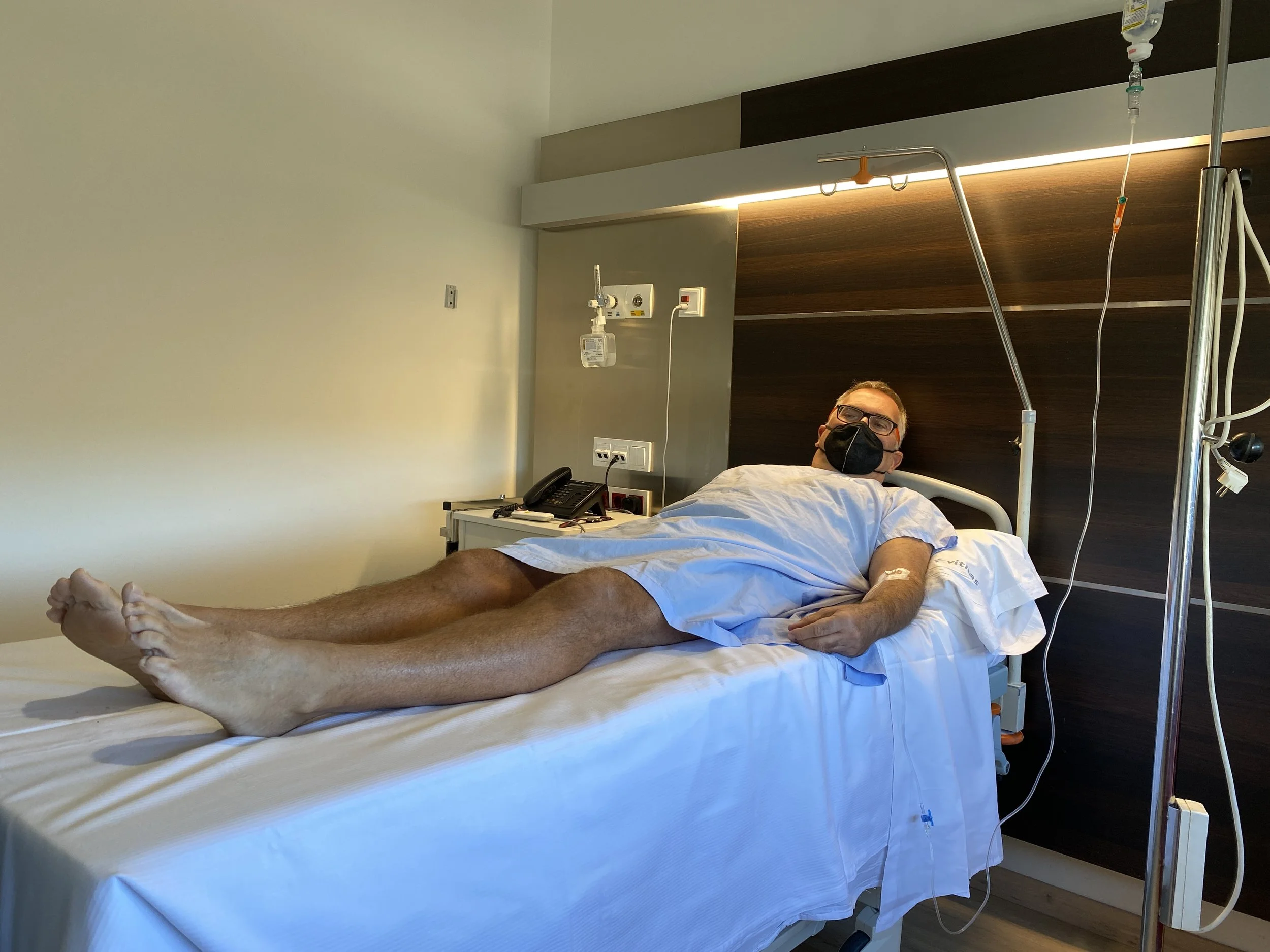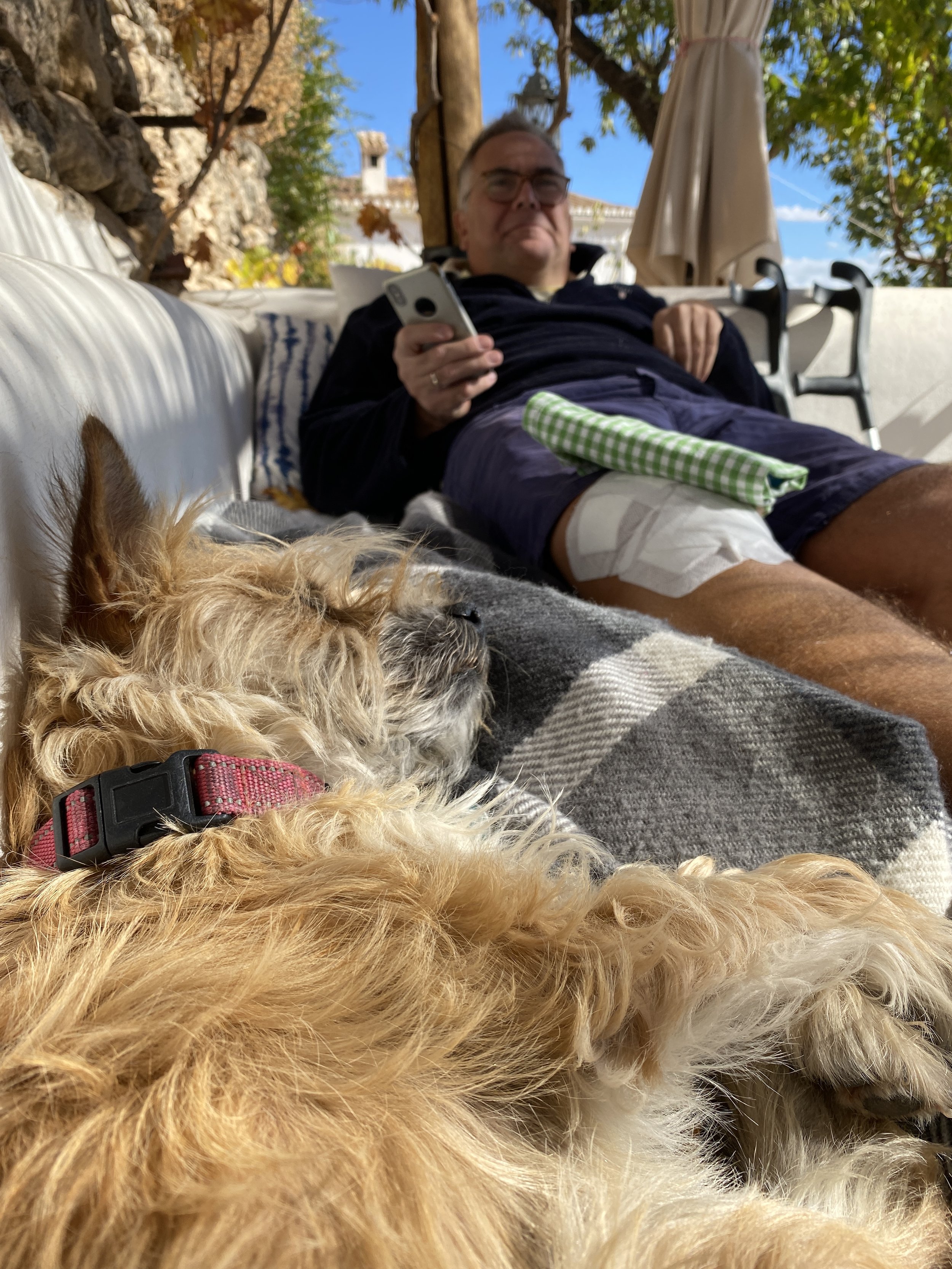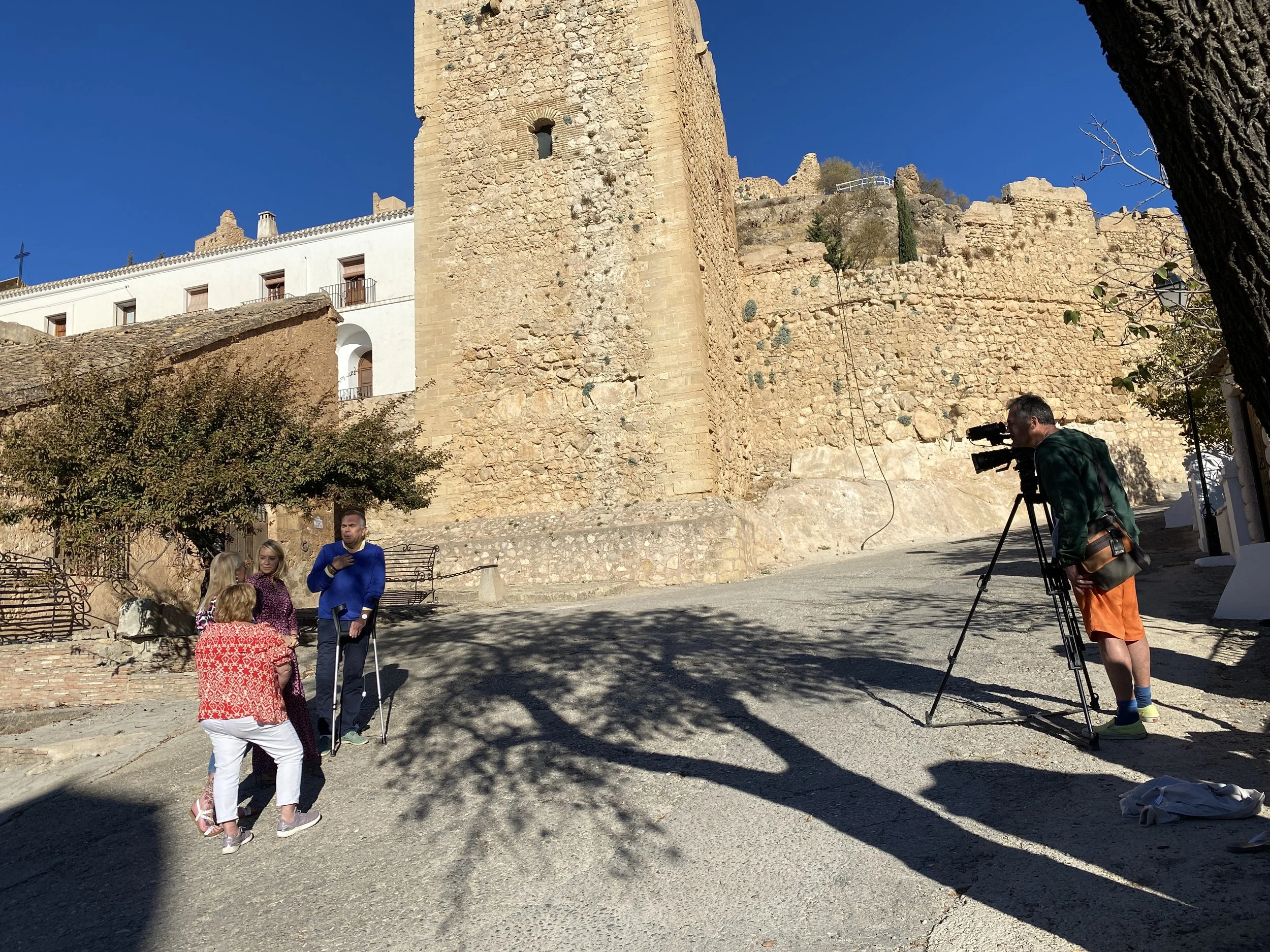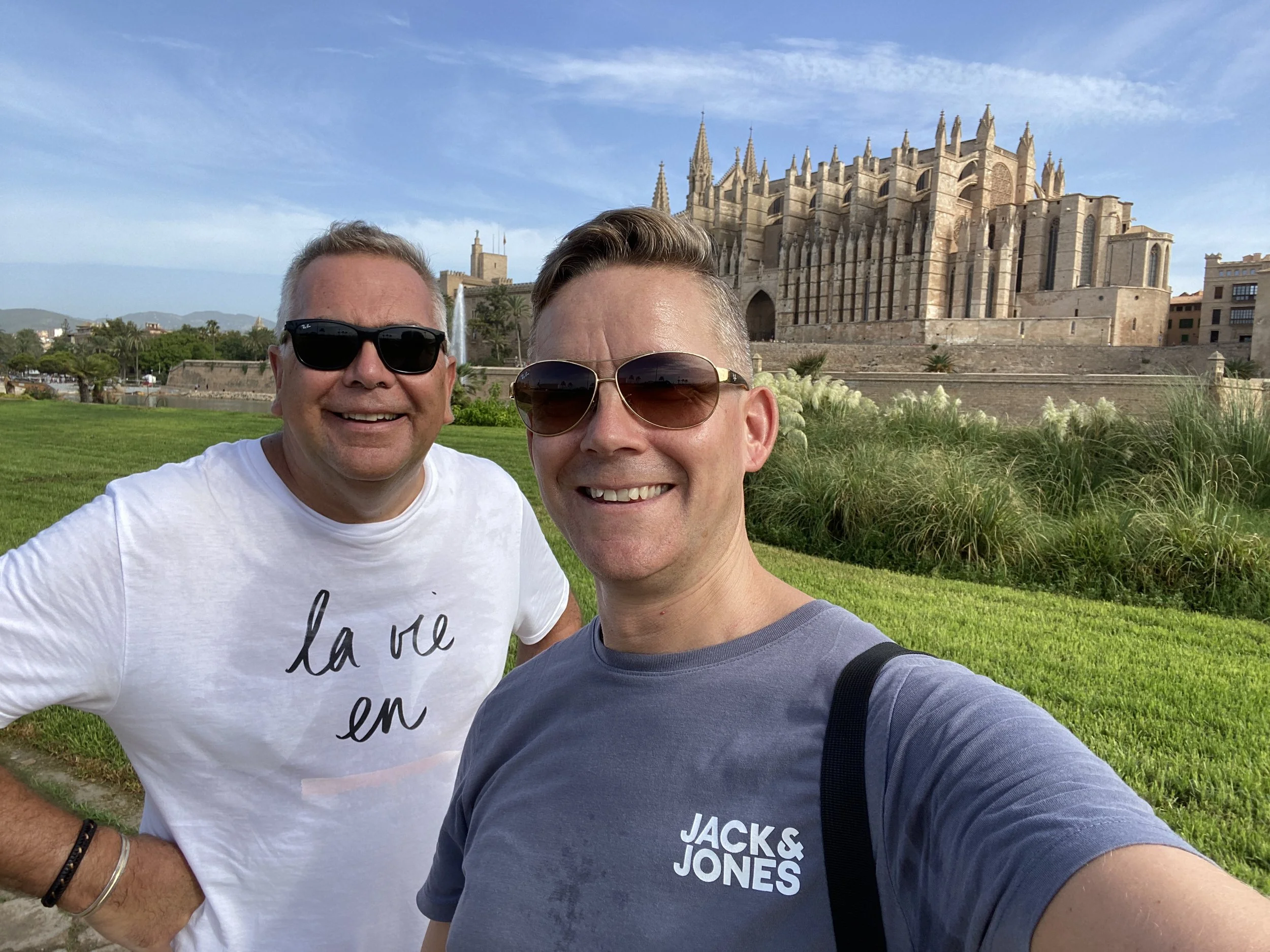Hospital Adventures
September and October went by in something of a blur so here we find ourselves well embedded in November and I am lying, recuperating, on the bed. Recuperating, not from some late night carousing or from the speed with which we did actually shoot through the last two months, but because I have just had knee surgery. It seems appropriate, therefore, that we chat a little about our recent experiences of the Spanish healthcare system.
I’ve always had slightly dodgy legs. Both my Mum (sadly no longer here) and Andrew (who is very much here) have both previously made nasty little asides about my bandiness and the clear misalignment of my legs eventually came to a head shortly after one of our ski trips. For about 18 months, I’ve suffered from pain in both my knees. On some occasions, the pain has been so debilitating that I have barely been able to walk. On other occasions, I have been able to go about our business without too much trouble, but all this did rather put paid to the long hikes we used to enjoy. I could just about do the Ruta del Gollizno, our local route, but I would pay for it the next day.
Eventually, I could take no more so decided to head directly to the traumatología department of the Vitas Hospital in Granada.
I’ll go back a little bit now and explain that we took out private health insurance in 2016, just before we moved to Spain, as it was one of the requirements for getting residency: we had to demonstrate that we were not going to be a burden on the state, quite understandably.
We now pay tax and social security in Spain, so we are eligible for state healthcare, and I will touch on this later, but we decided to keep the Sanitas insurance running as it was pretty good value. I have also had a fair bit of dental work done on our policy, as during lockdown I needed two root canal treatments, an extraction and an implant - I don’t believe in doing things by halves.
In June of this year, I took myself off to the Vitas hospital to have my knee pain investigated. The first treatment, on both knees at different times, was an infiltración which consists of the insertion of a long needle directly into the knee and the injection of various anti-inflammatory, analgesic and regenerative solutions. It is as uncomfortable as it sounds, and for a week after the procedure, the pain was most unpleasant. My children, and Andrew for that matter, seem to think I scream like a baby at the first sign of pain, but I feel that this is unduly unfair!
The infiltración can only bring temporary relief, generally for around 6 months, and then it is highly likely that another solution will need to be found. I was under the care of Dr Carlos Arjona, one of the specialists in the Clinica Martín Gómez at the Vitas Hospital, and I cannot commend him highly enough. Interestingly, the consultants do everything - initial consultation, infiltración, surgery and post-operative care, so I never felt as though I was being passed from one team to another. I can get by in Spanish now, but it can still be tricky when chatting about medical procedures when the terminology is tricky in any language, but I always felt looked after.
Once the effects of the initial temporary injections wore off, Dr Arjona discussed the next steps and the need for an osteotomía (osteotomy). This is not a knee replacement, but it is a surgical procedure that can prevent (or delay) the need for a full replacement 10 or 15 years down the line. Fortunately, as I didn’t understand every word of the medical conversation, it was easier for me to place my trust in the good Dr Arjona and go with his advice. The procedure consists of the cutting of part of the tibia to straighten the leg, thereby relieving pressure on the side of the knee joint that is causing the ongoing pain. Dr Arjona showed me the x-rays of my definitely-not-straight legs with a marked intake of breath, as if he had never seen such bandy legs before in his life. I nodded, as if looking at someone else’s legs completely.
Just like that, it was decided to operate and I was booked in for surgery on 7th November.
In the Vitas Hospital system (it may well be the same in the state system, too) the patient is responsible for a lot of their own patient management. I understand that it might be different if the patient is referred by their GP in the first instance, but because I had gone direct to the traumatology department, then it was all down to me. This is where I found the system frustrating and anxiety-inducing and I hope that, by sharing my experience, this might help anyone else who happens to find themselves on this little journey. I would have found it hugely helpful to have been handed a guide to the pre-op process, so I could have seen a complete overview of the systems and what is needed. Instead, I was given lots of verbal information (which is difficult to ingest at the best of times when faced with the prospect of major surgery) and left to get on with it. In brief, before surgery, the patient needs to get various analyses done, meet with the anaesthetist and then ensure that all the paperwork is submitted to their healthcare insurer to get authorisation for the procedure.
I stumbled at the first hurdle, as I didn’t know exactly what tests needed to be done so that the anaesthetist could do his sums and determine that he wasn’t going to kill me. I had to have blood taken for analysis, but didn’t realise that I then had to go elsewhere for an ECG. This lack of understanding did cause a deal of stress and anxiety and in the end I had an appointment with the anaesthetist during which I explained that I did not understand the process and needed to have the step by step system written down. He very kindly did write everything down and liaised with my consultant directly, and everything was solved. Correct tests done, paperwork in hand and submitted to Sanitas.
Sanitas, just before the bank holiday for the Día de Los Muertos on 1st November, then asked for more information. They needed to know the manufacturer of the anaesthetic that would be used in my epidural for the operation and for post-op pain relief. I called the hospital three times, sent two emails, physically went into the hospital with the email from Sanitas, and still could not get the information I needed.
On 4th November, I had an appointment in the public hospital in Granada to have a mole examined. In the summer, one of my moles began to itch and my GP here in the village referred me to the dermatology department (interestingly coupled with the department for venereal diseases, but I digress). Andrew and I walked into the department where there was not one single other person. I checked in (machines spewing tickets are everywhere in the hospital system) and immediately got called into the consultant’s room where my moles were duly inspected. I have a few so thought it was a good opportunity to go through all the most worrisome offenders. All were deemed to be fine. I don’t think either of us have ever been to a medical appointment of any nature where we have not had to wait a second to be seen.
Just as we left that appointment, I had a called from Vithas Hospital asking me to go into to see them to get the missing information. I then got a further call confirming that, somehow, Sanitas now actually had the additional information and the surgery was approved. We have no idea what happened there, but one of my messages must eventually have got through.
One of the most frequently asked questions leading up to the date for the surgery was “how long will you be in”? I had absolutely no idea, as this had never come up in conversation and nor had I thought to ask. As I said, I was more than happy to go with the flow and hope for the best. I thought that maybe I should do a little online investigation to discover that, while one or two osteotomy patients might get to leave hospital on the same day as their procedure, most ended up staying for 1 - 3 days. Andrew’s face blanched, as he was facing the prospect of having to drive everywhere and he, prior to this point, hated driving.
I did take a few little personal items when we checked in on 7th November for the operation, and thought that if I did need anything else then Andrew could always bring items in later. From this point, the system at the hospital could not have been faulted. The staff were fabulous, the hospital in the surgical and accommodation wings spotless and the process beyond efficient. I think staff were slightly shocked that Andrew was not going to be staying with me in my room, as this does seem to be the order of the day in Spain. The patient has family always on hand to fetch and carry, wash and care. I was on my own!
As alluded to above, I had an epidural and sedative for the operation, so I was awake throughout the entire procedure and yet I felt absolutely no anxiety. In fact, there was something vaguely soothing about hearing music in the operating theatre and the chat between the team. I can remember hearing the saws, but thinking that they were just checking their equipment; I remember the surgeon saying OK to everyone as he presumably showed off the results of the surgery before I was stitched up. Other than that, I just thought it was all a rather pleasant 5 minutes. The surgery actually took an hour and a half.
I was whisked off into recovery and then for an X-Ray before being taken back to my room and from my bed I had glorious views of the mountains above Granada, sun streaming through the window.
Ian leaving The Vithas Hospital, Granada
Andrew did eventually come back, the next day, after I had been given the all-clear to leave. The epidural remained inserted and I was given instructions on how to zap in the occasional top-up of anaesthetic when any pain kicked in. I realised, again, that the patient was responsible for any additional bits and bobs, such as crutches and without which I would be going absolutely nowhere. Frantic calls were made to neighbours in the village and a pair of crutches was found. Physiotherapy, too, is outside the remit of any of the hospitals and is the responsibility of the patient. The consultant will provide the prescription for treatment and a report, but then the patient does the rest.
I have spent the past week doing what I can (more in the next blog post!) and reading lots of advice along the often contradictory lines of - “do your exercises!”, “don’t overdo it!”, “get started as soon as you can”, “don’t do too much too soon”, “take your time”. I had the epidural removed on Thursday when I went to have my bandages removed. My whole leg had been swathed in tight bandages post-op, and the great reveal showed some very neat scars, two of which had metal staples. Andrew was fascinated. For my part, I thought my leg looked rather liked an overstuffed, cornfed chicken that had been savagely plucked.
Now, I am anaesthetic-free but rather wish that I still had my zapper at night. I am in turmoil as to how much movement is too much, but then realise that my body will tell me. Trying to sleep at night is not easy, as the slightest twist of the knee is painful enough to wake me up. During the day, progress is slow but manageable and Andrew is just the best nurse! He has even started to get mildly excited about driving, and if nothing else comes from this episode then that one thing will be enough.
The consultant has seen my latest X-Rays and is very happy with the outcome. For the first time in 60 years, I have one straight leg and I can now look forward to the next one being straightened in 6 months’ time. In the meantime, I may have to confiscate the car keys or Andrew may well disappear into the sunset.
Alfie helping with recovery









